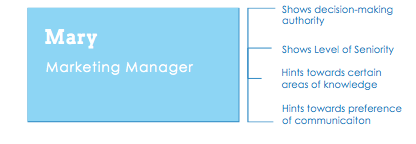The Critical Components of Your Buyer Personas
Inbound marketing success depends on the quality of your Buyer Personas. Your business’s marketing team uses the personas to focus their marketing efforts. The sales team uses the personas to craft their sales strategies. With the wrong personas, their efforts will not have the impact they should have. That's why it's vital that you thoroughly understand the components of your buyer personas.
You know how critical these personas are. We’ve discussed how to create buyer personas and how to construct them. But, where do you start? It is not uncommon for someone to stare at their computer screen with no clue about how to begin.
The Critical Components
The best way to start is to first focus on the critical components of the Buyer Persona. All the data you gather will help define the full picture. However, these critical components will give your sales and marketing teams a solid starting point. In fact, with this information, you can make critical sales and marketing decisions with a good level of confidence.
Let’s look at the critical components in detail to see why they are important and how you use the information in your persona.
1. What is the customer’s demographic profile?
Demographic information includes answering questions like:
- Is this person male or female?
- Does this person have children? If so, how old?
- How old is this person?
- How much does he or she make each year?
- Where does this person live?
This demographic information gives you an outline on which to start building your persona. It is easier to get than most other information. It provides a personal picture of your customer. This information is valuable because it helps you focus your offline and online marketing efforts. For example, if your target is a college-aged male still living at home, your marketing and sales efforts will differ than if the target is a woman in her 40s working a white-collar job, married, with five kids.
2. What is this person’s job, the title, and his or her level of seniority?
A major part of many people’s lives is their job. When it comes to creating a persona, this information can have different levels of importance, depending on what your company offers.
If you are a company that sells to consumers, this information helps you understand the details of the customer’s life. It helps you understand if your products appeal to professionals or blue-collar workers. Do your customers come from the same industry? That information gives a clearer picture of what drives this persona.
If you are a company that sells to companies, the customer’s job becomes critical. Your customers hold a certain position and decision-making authority within their company. Is this person an executive or at a high level of management? Is this person at a lower level? Knowing the person’s title and level of seniority helps you understand the customer’s preferences for communications and marketing. It helps to show the decision-making process within the company and what this person goes through to purchase products or services.
-
Shows decision-making authority
-
Shows Level of Seniority
-
Hints towards certain areas of knowledge
-
Hints towards preference of communication
3. What does a day in this person's life look like?
A person is more than his or her demographic data and job. This person lives life. Your persona needs to capture what a typical day looks like for your ideal customer. This will integrate the personal and professional aspects of life into one comprehensive picture. Here are some examples of the type of details your persona needs:
-
Does this person spend more time at home or at work?
-
Where would he or she rather be?
-
What does this person like to do for fun?
-
Which person or persons matter most in this person’s life?
-
What vehicle does he or she drive?
-
What TV shows, if any, does this person watch?
-
What type of clothing does this person feel most comfortable wearing?
Now, you can add or subtract as much detail as you want. The idea is to get a good mental picture of this person. If you have any remaining fuzzy areas, get more information or make educated guesses.
Once you have a good outline of your persona, browse through some stock photos. Pick out a few that represent what makes your persona come alive. You can find a picture that looks much like your persona. Add one for the vehicle they drive. Add a picture representing what they like to do for fun. Add others that seem to fit. These photos help clarify the image to your marketing and sales staff. It humanizes the fictional character.

4. What challenges and pain points does your customer have? How can your product or service solve them?
Your product or service helps to solve a problem in your target audience. You need to understand how this problem affects daily life. Your persona needs to detail how this problem makes the customer feel (frustration, intimidation, fear of doing something wrong, etc.).
For example, let’s say your company offers website templates for sale to small businesses and individuals.
One of your personas is a person just opening a small business who needs a website up quickly. What are the pain points for this type of customer? If they are not a website designer, the idea of designing their own website is intimidating. They may be overwhelmed at the technical details involved. They have no idea where to start.
The pain points for another persona is entirely different. For example, let’s say a technically savvy teenager is looking for a fun template to use on his or her blog. The pain points for this persona would be frustration in not finding templates that show his or her personality. They have found templates geared towards younger kids and those geared towards young adults, but nothing for their age group and interests.
5. What does this customer value most?
When you know the customer’s pain points, you will get clarity in what that person values most. You also get insight into what they do not care about. What gets the customer excited about your product or service?
For example, using the website template example, for the start- up business owner, an easy-to-install template is more valuable than a highly complicated one. If your website offers simple-to-use instructions for installation and customization, then you offer that person even more value.
For the tech-savvy teenager, creative, leading edge design is more valuable in their eyes. They want something that will make their personal presence online something that will impress their friends.
6. What is this customer’s preference for getting information? Where do they go? Who do they trust?
You need to understand your persona’s preferences for consuming information. Some people use the Internet for information gathering. Others do better in face-to-face meetings. Still others are comfortable with reading newspapers, magazines, and journals. You need to delve even deeper into the details. For example, if the person prefers to go online, does he or she use social networks? Do they prefer Google or Bing?
Which sources does this person trust? Common answers include friends, family, co-workers, or industry experts. However, knowing which one is their preference will influence your marketing message and focus.
When you know their information gathering preferences and who they trust, you can place your marketing message in the right spot at the right time.
7. What kind of experience does this person want to have when purchasing and using your products and services?
Each person has certain expectations for their sales experience. What should the sales experience feel like? Does it feel like a consultation? How much time should the transaction take? Is this a face-to-face experience, or solely online? The customer also has expectations for when he or she uses this product or service. What features do they want to see?
This information helps you align your product and service as well as your marketing message with your persona.
8. What is the customer’s most common objections to your product or service?
No product or service is perfect for every customer on the planet. If you can anticipate potential objections from your customers that fit the persona, you can address them during the sales process. You can educate your target audience with your marketing.
What makes this person hesitant to buy your product? Is he or she a first-time Buyer of this type of product or service? If not, why are they looking to switch products or services?
Okay, at this point, you have a deep understanding of what makes your persona tick. Now you have the ability to tailor your communications to your audience. You can focus your marketing and sales messages.
You also have the ability to spot a potential customer faster. When you know their job title, their demographic information, and their typical forms of communications, spotting a new lead becomes much easier. You and your employees will have no problems communicating with this person. Plus, you will have a consistent voice in how your company presents itself. And that is a smart thing for any business.
Sometimes it’s tricky to nail down your business’s ideal buyer persona and target audience. We at ROI Online can help guide you in the right direction when it comes to determining your buyer persona. If you can't wait until our next blog on Buyer Personas, download our free Buyer Persona eBook today!





